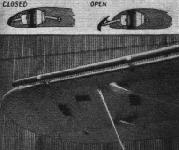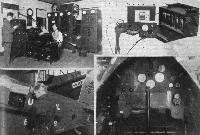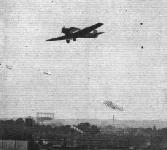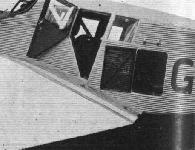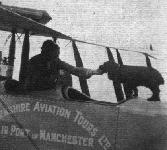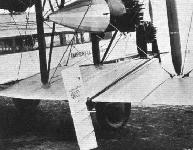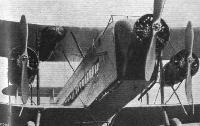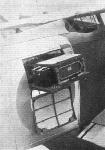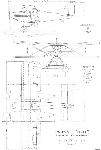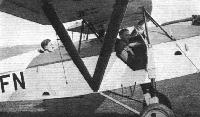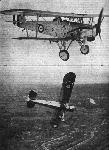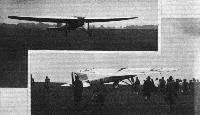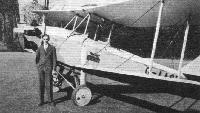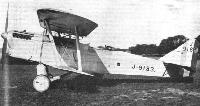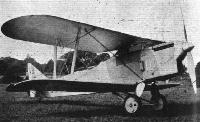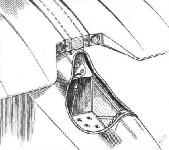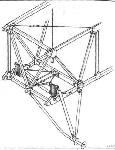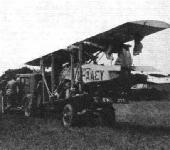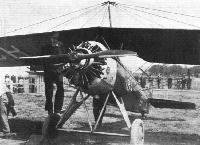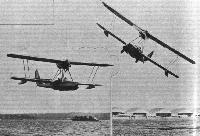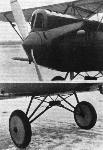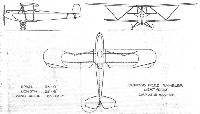Фотографии
-
Самолёты на фотографии: Curtiss F7C Seahawk - США - 1927
-
Самолёты на фотографии: Douglas M-1 - M-4 - США - 1925
-
W. L. Smith, the veteran pilot, and Superintendent of the Eastern Division of N.A.T. air lines, who made a successful test of the directional, or radio beacon apparatus, during which he flew in dense fog and rain, in spite of which he was at all times in close touch with the airport, and landed safely.
Самолёты на фотографии: Douglas M-1 - M-4 - США - 1925
-
US. AIR MAILS AND WIRELESS: (1) The interior of the radio airway broadcasting station of N.A.T. air services. Here weather reports and other information are received over the teletype and broadcast to the Pilots In flight. (2) Radio equipment for mail and express plane, showing pilot s helmet and earphones, the switchboard, the receiving set and battery. (3) The set is installed in the fuselage aft of the pilot's cockpit, from where it is operated by remote control shown in (4), the switchboard being located on the left.
Самолёты на фотографии: Douglas M-1 - M-4 - США - 1925
-
Great and Small at the Winnipeg Aviation Meet, May 24 and 25. The 65 h.p. Monocoupe of Mr. Verne Roberts and the tri-motor Fokker owned by the Western Canada Airways.
Самолёты на фотографии: Central States Monocoupe 22 - США - 1927Fokker F.VII / C-2 / F.XIV - Нидерланды - 1924
-
Самолёты на фотографии: Junkers F 13 - Германия - 1919
-
Note large luggage compartment.
Самолёты на фотографии: Junkers F 13 - Германия - 1919
-
The Vickers "Vimy" Biplane, with two 350-h.p. Rolls-Royce engines, piloted by Capt. John Alcock, with Lieut. Arthur Whitten Brown, leaving Newfoundland on June 14, 1919.
Самолёты на фотографии: Vickers Vimy / FB.27 - Великобритания - 1917
-
A DRESS REHEARSAL: A striking picture, taken from the air, of six airmen making a simultaneous parachute drop from three Vickers "Vimy" bombers, during a rehearsal of this event, at Henlow, for the forthcoming R.A.F. Display.
Самолёты на фотографии: Vickers Vimy / FB.27 - Великобритания - 1917
-
Capt. Lawson, Chief Pilot of Berkshire Aviation Tours, Ltd., receiving the approval of his pet after giving a display of stunting for the Manchester people.
Самолёты на фотографии: Avro Avro 504 - Великобритания - 1913
-
The Mk II Argosy had geared Jaguar engines and, at least on the first aircraft, Townend ring cowlings.
A view of the complete machine, from which it will be seen that the new "Argosy," in general appearance, follows the original "Argosy" air liners which have been giving such excellent service on the London-Continental air route during the last three years. Points of interest to note in this view are the neat engine cowlings, with Townend rings, and the Handley Page slots.Самолёты на фотографии: Armstrong Whitworth Argosy - Великобритания - 1926
-
We understand the controls are particularly light and effective, and a point of interest in this connection is the fitting of servo control for the ailerons. This servo rudder, which is seen in the centre illustration, is mounted on the lower plane as shown, and can be adjusted by the pilot.
Самолёты на фотографии: Armstrong Whitworth Argosy - Великобритания - 1926
-
The cruising speed of this "Argosy" is 95 m.p.h., at which speed the petrol consumption is 65 gallons per hour. The tanks - which may be seen on the upper plane in our illustrations - have a capacity of 360 gallons, which gives an endurance of 5 1/2 hours. The machine can take off with full load in 200 yards and will fly easily on any two engines at an altitude of 2.000 ft.
Самолёты на фотографии: Armstrong Whitworth Argosy - Великобритания - 1926
-
Inspection is facilitated by quickly-detachable panels. The photograph shows the wireless compartment.
Самолёты на фотографии: Parnall Pipit - Великобритания - 1928
-
THE PARNALL "PIPIT": A dihedral on the top plane only is one of its characteristic features.
Самолёты на фотографии: Parnall Pipit - Великобритания - 1928
-
Регистрационный номер: N232 [3] THE PARNALL "PIPIT": In this three-quarter rear view the fuselage covering is shown in place.
Самолёты на фотографии: Parnall Pipit - Великобритания - 1928
-
Регистрационный номер: N232 [3] THE PARNALL "PIPIT": With Fuselage Side Panels removed.
Самолёты на фотографии: Parnall Pipit - Великобритания - 1928
-
Inspection is facilitated by quickly-detachable panels. The photograph shows the whole forward portion stripped.
Самолёты на фотографии: Parnall Pipit - Великобритания - 1928
-
Регистрационный номер: N232 [3] THE PARNALL "PIPIT": Clean lines characterise this single-seater Ship's Fighter. The engine is a Rolls-Royce "F" type.
Самолёты на фотографии: Parnall Pipit - Великобритания - 1928
-
ONE OF THE ALL-METAL WINGS OF THE "PIPIT": The petrol tank is housed in the inner bay, and the photograph shows how the drag bracing, in the form of tubes, is carried around this bay.
Самолёты на фотографии: Parnall Pipit - Великобритания - 1928
-
THE CONTROL UNIT ON THE "PIPIT": Three-point suspension is adopted, and the pilot's seat can be raised and lowered. It is shown in the raised position on the left. Rubber cords are used to balance the weight of the pilot. The retractable radiator is supported on a threaded column as shown, and is operated by one of the two hand wheels.
Самолёты на фотографии: Parnall Pipit - Великобритания - 1928
-
Parnall "Pipit" Rolls-Royce F Type Engine
Самолёты на фотографии: Parnall Pipit - Великобритания - 1928
-
Регистрационный номер: G-AAFN This photograph shows the exceptional easy access to the cockpits of the Westland "Widgeon" monoplane, and the freedom of view downwards, particularly from the passenger's cockpit. Incidentally, the new undercarriage is seen on this machine. Mr. H. Penrose is in the rear cockpit. He is one of the Westland Aircraft Co.'s pilots.
Самолёты на фотографии: Westland Widgeon - Великобритания - 1924
-
Herr Neuenhofen (right), who reached an altitude of 41,740 ft. on May 26 in the Junkers "Bremen" low-wing monoplane fitted with Bristol "Jupiter" engine, by which he is standing, with his two Junkers engineers, Herr Thiedemann (centre) and Herr Schinzinger, who were responsible for the technical preparations. Subject to official confirmation, this altitude figure is a world's record.
Самолёты на фотографии: Junkers W 33 / W 34 / Ju.46 - Германия - 1926
-
Mr. John Tranum astride the Klemm monoplane in flight.
Самолёты на фотографии: Klemm L.25 - L.28 Swallow - Германия - 1927
-
HORSLEYS FOR HELLAS: These photographs show the first of a batch of Hawker "Horsleys" on order for the Greek Government, two of whose representatives, Commander Falconakis and Lieut. Plastiras, may be seen on board. The pilot was Lieut. Bulman, and the photographs, which were taken from another aeroplane, indicate the manoeuvrability of the machine which, in the lower picture, is in an almost vertical bank.
Самолёты на фотографии: Hawker Horsley / Dantorp - Великобритания - 1925
-
Регистрационный номер: J9479 [2] Flying over Cranwell Aerodrome, the scene of successful start for India.
Самолёты на фотографии: Fairey Long-Range Monoplane - Великобритания - 1928
-
Регистрационный номер: J9479 [2] Cranwell Officers, Cadets and Aircraftsmen welcome the return of the Fairey monoplane (Napier) from India, on June 15. The monoplane is seen making its punctual landing, after flying the last stage from Le Bourget, and taxi-ing in.
Самолёты на фотографии: Fairey Long-Range Monoplane - Великобритания - 1928
-
This is a section of the Manchester crowd at the Pageant last Saturday watching the Avro "Avian" (their own production) take-off.
Самолёты на фотографии: Avro Avian / Type 594/616 - Великобритания - 1926
-
Регистрационный номер: G-AACF The Earl of March with his Avro "Avian" (Armstrong Siddeley "Genet") outside Goodwood House. The registration letters are G-AACF.
Самолёты на фотографии: Avro Avian / Type 594/616 - Великобритания - 1926
-
Регистрационный номер: J9183 [4] The Avro "Antelope" is a high-performance day bomber. This view shows the engine cowling, radiator and undercarriage.
Самолёты на фотографии: Avro Antelope / Type 604 - Великобритания - 1928
-
Регистрационный номер: J9183 [4] THE AVRO "ANTELOPE": Front view. Note the thinning-down of the top wing along centre line.
Самолёты на фотографии: Avro Antelope / Type 604 - Великобритания - 1928
-
Регистрационный номер: J9183 [4] THE AVRO "ANTELOPE": Side view. The engine is a Rolls-Royce F. XI B.
Самолёты на фотографии: Avro Antelope / Type 604 - Великобритания - 1928
-
Регистрационный номер: J9183 [4] THE AVRO "ANTELOPE": Three-quarter front view.
Самолёты на фотографии: Avro Antelope / Type 604 - Великобритания - 1928
-
"ARAB ATTACK": Dr. J. Sleigh down in the "desert" with his "Bluebird," menaced by the "Arabs." Flt. Lieut. T. Rose dives to his assistance in the Gipsy-Moth (left), then two Blackburn "Bluebirds" ("Genets") come to complete the defeat of the "enemy."
Самолёты на фотографии: Blackburn Bluebird / L.1 - Великобритания - 1924De Havilland Gipsy Moth / Moth X - Великобритания - 1928
-
Регистрационный номер: F-AIKI THE "GOLDEN RAY" AIR PULLMAN SERVICE: The Air Union have recently introduced a new Pullman Air Service between London and Paris, known as the "Golden Ray." It is operated by new types of aircraft, shown here, which completes the journey in about 2 hrs. 10 mins. - 30 mins. faster than hitherto. The machine shown is the Bleriot 165, fitted with two 450 h.p. "Jupiters." It is of metal construction.
Самолёты на фотографии: Bleriot Bleriot-165 / -175 - Франция - 1926
-
The cockpit of the C.(L.A.) 7 "Swift," showing the altimeter and speed indicator mounted on the rear spar.
Самолёты на фотографии: Comper Swift / CLA.7 - Великобритания - 1930
-
Sketch showing the split-axle type landing gear of the C.(L.A.)7 "Swift." The shock absorbers are housed inside the fuselage.
Самолёты на фотографии: Comper Swift / CLA.7 - Великобритания - 1930
-
C(LA) 7 "Swift" A.B.C. "Scorpion" Engine
Самолёты на фотографии: Comper Swift / CLA.7 - Великобритания - 1930
-
OUR FIRST PRIME MINISTER TO FLY: Mr. Ramsay MacDonald, Prime Minister of the new Government, thanking his pilot on landing at Hendon on June 20 after flying from Lossiemouth in the R.A.F. Fairey IIIF, a distance of 500 miles. He is seen being received by Wing-Commander W. J. Y. Guilfoyle, O.B.E., M.C., q.s. The pilot was Flight-Lieut. H. W. Heslop.
Самолёты на фотографии: Fairey Fairey IIIF - Великобритания - 1926
-
Регистрационный номер: G-AAEY The Henderson Glenny single-seater monoplane (A.B.C. "Scorpion") arriving at Conington. It was assembled and flown in remarkable time.
Самолёты на фотографии: Henderson & Glenny HSF.2 Gadfly - Великобритания - 1929
-
BRITISH ENGINES ABROAD: Three Heinkel seaplanes, fitted with Armstrong-Siddeley 460-500-h.p. geared "Jaguar" engines, belonging to the Danish Government, flying in formation
Самолёты на фотографии: Heinkel HE.1 - HE.5, HE.8 - HE.9 - Германия - 1923
-
Регистрационный номер: F-AIFE THE "GOLDEN RAY" AIR PULLMAN SERVICE: The Air Union have recently introduced a new Pullman Air Service between London and Paris, known as the "Golden Ray." It is operated by new types of aircraft, shown here, which completes the journey in about 2 hrs. 10 mins. - 30 mins. faster than hitherto. The machine shown is the Liore and Olivier 21 fitted with two 500 h.p. geared Renault engines.
Самолёты на фотографии: Liore et Olivier LeO 21 - Франция - 1926
-
Mr. Randolph Trafford with his Morane-Saulnier parasol monoplane (MS.137) fitted with a 120-h.p. Salmson engine. Not many private owners go to France for their machines, but Mr. Trafford is very pleased with the performance of this successor of a war-time fighter - the old "M.S." parasol, which saw so much service, not only in the French, but Allied Air Forces.
Самолёты на фотографии: Morane-Saulnier MS.137 / MS.138 / MS.147 - 149 / MS.191 - Франция - 1927
-
A NEW ITALIAN-AMERICAN AMPHIBIAN: Two views of the American Savoia Marchetti "S.56." The well-known Italian Savoia machines are being constructed in America by the American Aeronautical Corporation of New York. The "S.56" is a three-seater "Baby" amphibian equipped with an American engine of 100 h.p. It has an overall span of 34 ft. 1 1/2 ins. and a speed range of 38-92 m.p.h. Dual control is fitted, so the machine is equally suitable for instruction work or passenger carrying.
Самолёты на фотографии: Savoia-Marchetti / SIAI S.56 - Италия - 1924
-
CIRRUS SERVICE: Only the cynic will say that here is Capt. N. Stack carrying a spare engine in his D.H.9 in case of trouble with the other one. Actually this photograph gives an example of Cirrus Service. A Cirrus Mk. III' engine, which everyone will recognise, was urgently needed by the Blackburn Aeroplane Co., Brough, E. Yorks, so the two back seats were removed from the D.H.9 by the A.D.C. Aircraft, Ltd., to convey the engine by air, much to the mutual satisfaction of the two aviation companies.
Самолёты на фотографии: De Havilland D.H.9B / D.H.9C - Великобритания - 1919
-
This "oil well" burned well in the "desert" of Wythenshawe, but the fire-fighters, who flew up from civilisation in the D.H.9c soon stopped the rot. This was only one of the spectacular shows staged on Saturday.
Самолёты на фотографии: De Havilland D.H.9B / D.H.9C - Великобритания - 1919
-
The neat engine cowling and landing gear of the Curtiss-Reid "Rambler."
Самолёты на фотографии: Reid Rambler - Канада - 1928
-
THE CURTISS-REID "RAMBLER": Front and side views of the Canadian all-metal light 'plane, with "Cirrus III" engine.
Самолёты на фотографии: Reid Rambler - Канада - 1928
-
Curtiss Reid Rambler Light Plane Cirrus III Engine
Самолёты на фотографии: Reid Rambler - Канада - 1928
-
Lady Bailey starting up her Coupe "Gipsy-Moth" to play the role of Red Cross Nurse in the "Arab attack."
Самолёты на фотографии: De Havilland Moth Coupe - Великобритания - 1928
-
Регистрационный номер: G-AACY HESTON AIR PARK: One of the lock-up garages which contains 20 lock-ups. The machine is the Airwork, Ltd., Gipsy-Moth, fitted with Handley Page slots.
Самолёты на фотографии: De Havilland Gipsy Moth / Moth X - Великобритания - 1928
-
H.R.H. Prince Bertil (left) and H.R.H. Prince Carl Johan, sons of the King of Sweden, at Stag Lane Aerodrome recently. They inspected the De Havilland Aircraft Co., Ltd., works and were taken for flights by Capt. A. S. White in the Gipsy-Moth.
Самолёты на фотографии: De Havilland Gipsy Moth / Moth X - Великобритания - 1928
-
Mrs. A. S. Cleaver and Capt. Donald Drew, on their arrival at Croydon, after flying 12,000 miles to Karachi and back in the former's Gipsy-Moth.
Самолёты на фотографии: De Havilland Gipsy Moth / Moth X - Великобритания - 1928
-
Регистрационный номер: G-AADV THE FIRST BRITISH AMPHIBIAN LIGHT 'PLANE: These four photographs show a de Havilland "Gipsy-Moth," belonging to Mr. John Scott Taggart, for which Short Brothers have designed and built an amphibian undercarriage. The photographs show the machine in flight over Lympne aerodrome and, at rest on the waters of the Midway off the Short Works. The pilot is Mr. Lankester Parker.
Самолёты на фотографии: De Havilland Moth Seaplane - Великобритания - 1926
Статьи
- Flight
- Flight Advertisements
